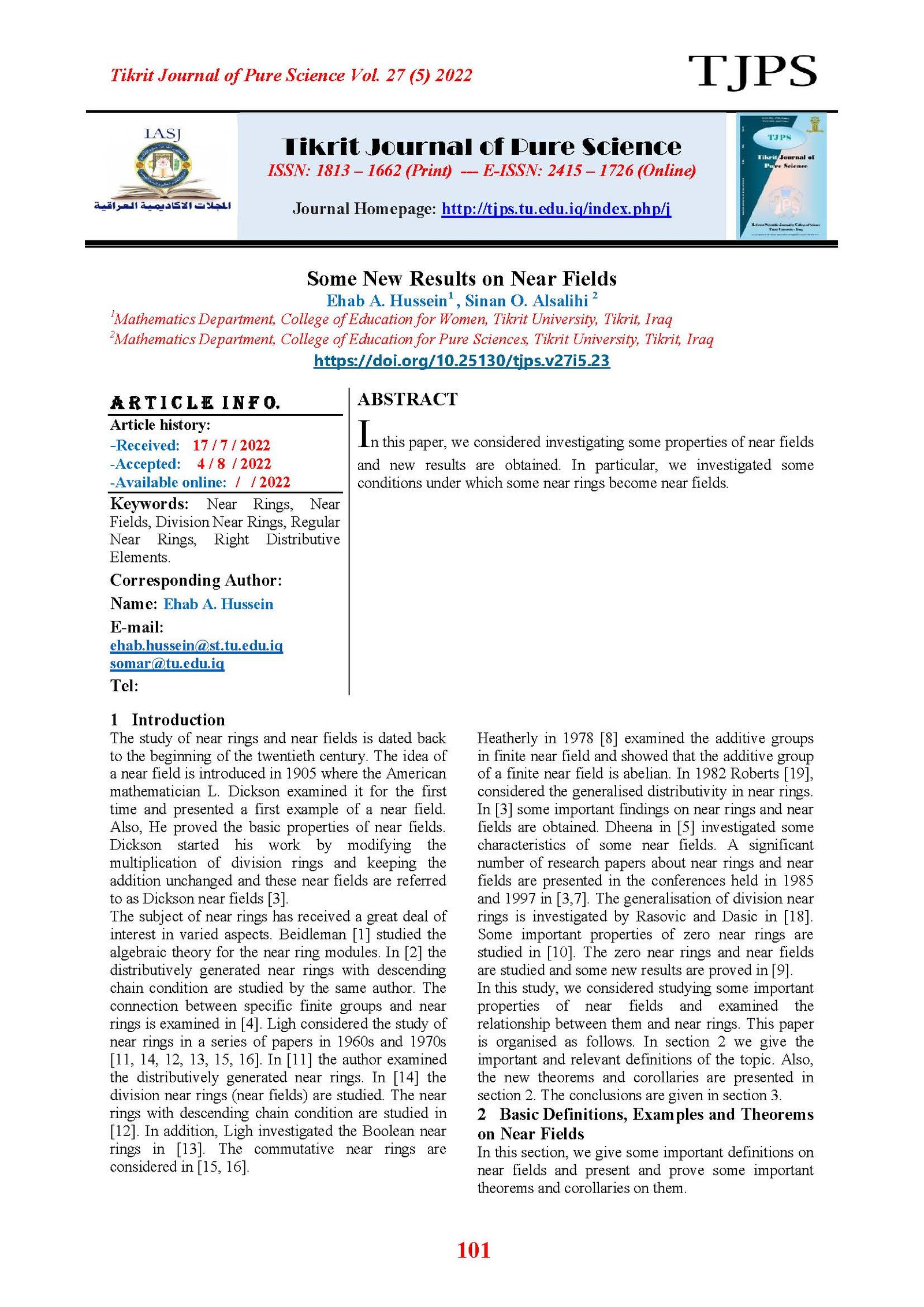Some New Results on Near Fields
Main Article Content
Abstract
In this paper, we considered investigating some properties of near fields and new results are obtained. In particular, we investigated some conditions under which some near rings become near fields.
Article Details

This work is licensed under a Creative Commons Attribution 4.0 International License.
Tikrit Journal of Pure Science is licensed under the Creative Commons Attribution 4.0 International License, which allows users to copy, create extracts, abstracts, and new works from the article, alter and revise the article, and make commercial use of the article (including reuse and/or resale of the article by commercial entities), provided the user gives appropriate credit (with a link to the formal publication through the relevant DOI), provides a link to the license, indicates if changes were made, and the licensor is not represented as endorsing the use made of the work. The authors hold the copyright for their published work on the Tikrit J. Pure Sci. website, while Tikrit J. Pure Sci. is responsible for appreciate citation of their work, which is released under CC-BY-4.0, enabling the unrestricted use, distribution, and reproduction of an article in any medium, provided that the original work is properly cited.
References
[1] Beidleman, J. )1964(. On Near rings and Near ring Modules, PhD thesis, the Pennsylvania State University, Pennsylvania, USA.
[2] Beidleman, J. (1966). Distributively generated near rings with descending chain condition, Math. Zeitschr, 91, pp. 65–69.
[3] Betsch, G. (1985). Near rings and near fields, Proceedings of a Conference held at the University of Tübingen, F. R. G. 4-10 August, North-Holland Mathematics Studies, 137.
[4] Clay J. and Malone, J. (1966). The near rings with identities on certain finite groups, Math. Scand., 19, pp. 146–150.
[5] Dheena, P. (1986). On near fields, Indian J. of Pure Appl. Math., 17, pp. 322–326.
[6] Fain, C. (1968). Some Structure Theorems for Nearrings, PhD thesis, the University of Oklahoma, Oklahoma, USA.
[7] Fong, Y., Maxson, C., Meldrum, J., Pilz, G., Walt, A. and Wyk, L. (2001). Near rings and near fields, Proceedings of the Conference on Near Rings and Near fields, Stellenbosch, South Africa, July 9-16, 1997, Springer Science + Business Media.
[8] Heatherly, H. (1978). The additive group of a finite near field is elementary abelian, Kyungpook Math. J., 18.
[9] Hussein, E. (2022). Some new results on near rings and near fields, MSc thesis, Tikrit University, Tikrit, Iraq.
[10] Hussein E. and Alsalihi, S. (2022). Some new results on zero near rings, Int. J. Non. Anal. Appl. (IJNAA). Accepted for publishing.Ligh, S. (1968). On distributively generated near rings, Proc. Edinburgh Math. Soc., 16, pp. 239-243.
[12] Ligh, S. (1969), Near rings with descending chain condition, Compositio Mathematica, 21, pp. 162–166.
[13] Ligh, S. (1969). On boolean near rings, Bull. Austral. Math. Soc., 1, pp. 375–379.
[14] Ligh, S. (1969). On division near rings, Canad. J. Math., 21, pp. 1366–1371.
[15] Ligh, S. (1970). On the commutativity of near rings, I, Kyungpook Math. J., 10, pp. 105–106.
[16] Ligh, S. (1971). On the commutativity of near rings, II, Kyungpook Math. J., 11, pp. 159–163.
[17] Pilz, G. (1983). Near rings, North Holland Publishing Company.
[18] Rasovic S. and Dasic, V. (2018). On generalization of division near rings, Italian Journal of Pure and Applied Mathematics, 40, pp. 1–8.
[19] Roberts, I. (1982). Generalized distributivity in near rings, MSc thesis, University of Edinburgh, Edinburgh, UK.
[20] Samman, M. (1998). Topics in Seminear ring Theory, PhD thesis, University of Edinburgh, Edinburgh, UK.
[21] Satyanarayana B. and Prasad, K. (2013). Near Rings, Fuzzy Ideals, and Graph Theory, CRC Press, Taylor & Francis Group.
